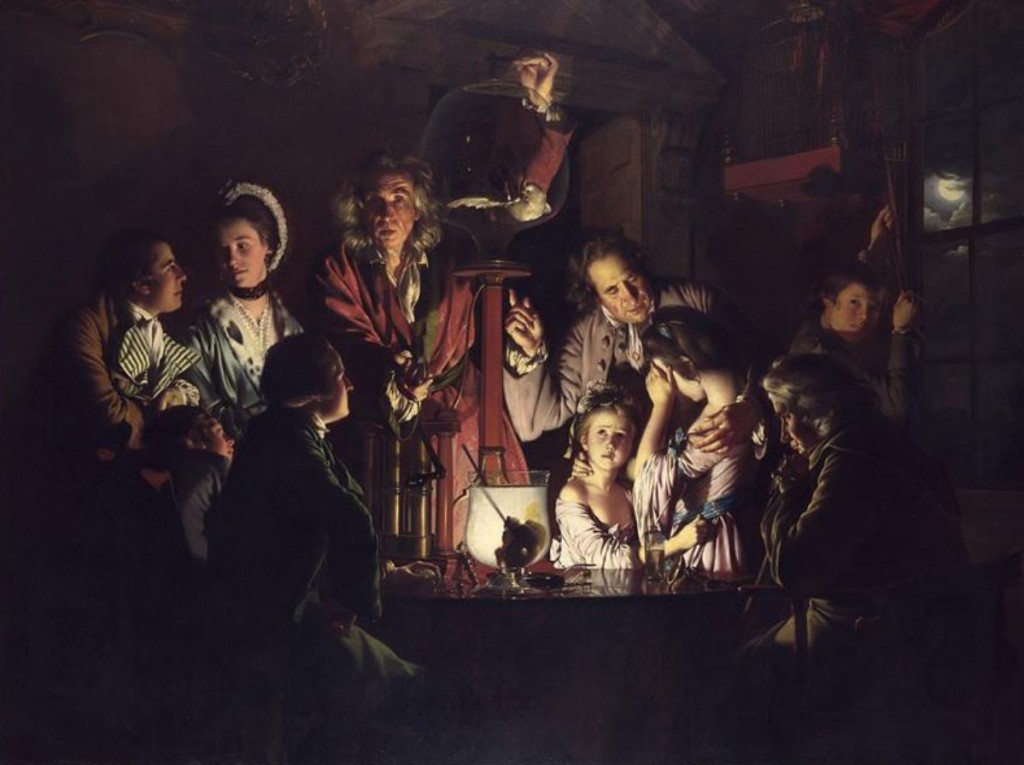
I’m not the fanciest person. I’m one of the last people you’d want to hear from if you wanted to know more about abstract art. There is, apparently, a Picasso hanging in the National Gallery in London called Fruit Dish, Bottle and Violin [1]. I know this because I looked it up (and just FYI, that’s an experience that will make google images look like it’s broken). If the painting was hanging when I was there I either didn’t notice it or don’t remember it, my bias and ignorance tending me to favour paintings that look a little more like their titles.
Instead, on my recent visit, I found myself spending a disproportionate amount of time sitting and staring at Joseph’s Wright’s An Experiment on a Bird in the Air Pump [2]. If I’m being completely honest with myself a big part of this was due to a glorious vacant bench sat right across from it, allowing me to rest some weary feet and listen to the audio guide. The rest is just because it is an amazing painting which could equally be entitled Mad Scientist Murders Beautiful Parrot.

I couldn’t do the painting justice with a detailed critique, thankfully for those who are interested there is a link to this one on the gallery’s website [3]. Suffice to say that one interpretation is that it depicts the illuminating, yet confronting, nature of a scientific view of the world and humanity’s place within it.
It probably doesn’t get too much more abstract than attempting to understand the physical properties of the invisible substance that is the air we breathe. Abstract concepts were at the heart of the Age of Enlightenment [4].
Over the last few years I have come to believe to that to be an investor is to embrace the abstract. It is to possess a greater optimism in the future of humanity’s progress than much of the rest of your peers. Whilst Joseph Wright’s painting of 1768 is of a time that celebrated this progress more than most, the thinking it championed has always been a part of human history. Even up to 100,000 years ago its presence was essential in allowing humans living in small social groups to hunt together and share information with each other through painting [5], thus creating a more prosperous future for themselves. Much later, the era immediately following the Age of Enlightenment – the Industrial Revolution – harnessed steam power and utilized both human and physical capital to further human progress on a scale unseen before that time [6]. Even the very notion of a company is born of an abstract concept.
Being ‘abstract’ does seem to have a bit of an image problem at times, and not one we can blame just entirely on modern artists. In daily life the words “it’s a little abstract” are often followed by “I’m afraid” or even “I’m sorry.” Where does this come from? Why is being even just a little bit abstract something we fear or feel the need to apologize for? I have my own theory on this.
I blame Mary Poppins. That’s right Mary Poppins, and her little snowdome of a place about 2.5km from the National Gallery with a pigeon problem [7]. The Mary Poppins who brainwashes through song the vulnerable sleepy children under her care into “feeding the birds” that plague St Paul’s Cathedral. The young Michael Banks, now indoctrinated into thinking that contributing to the life-cycle of an airborne pest is good way to spend coin, grabs hold of this idea like a rottweiler and refuses to let it go. This of course culminates in disaster when Michael’s new bohemian values later clash with the sheer common sense of wise and prudent investing [8]. A more eloquent person than myself, such as financial writer Morgan Housel, might point out the difficulty of the human mind to comprehend any non-linear concepts at the best of times [9]. That might well be true, but this predisposition is in no way helped by having the old men tasked with explaining compound interest and investing – for many of our first exposure to the concept – effectively stealing all the money the child possesses. Then again, as the Royal Commission attests, the bankers have probably always been their own worst enemies when it comes to PR.
The truth is that the sources of those caricatures – those men in the bowler hats and black suits – were the Elon Musks and Jeff Bezoses of the Victorian era. The fruits or their vision, innovation and investments are still seen in the railroads, architecture, bridges and subterranean infrastructure of the United Kingdom. Frankly, we should be grateful that they had 3 such little truck with allowing the children of London to waste their money feeding the rats of the skies.
And just a side-note. It’s most likely that the bird which was used in the type of experiment depicted in Wright’s magnificent painting was in fact a pigeon. The use of a beautiful cockatoo is almost certainly artistic license for dramatic effect. To be honest, it still seems cruel, and I am not advocating for hurting any bird be it parrot, pigeon or even ibis.
However, in an abstract sense I still appreciate the symbolism of it all: progress rarely comes without some sacrifice and delayed gratification.

Return to the Strawman Platform here
Strawman is Australia’s premier online investment club. Join for free to access independent & actionable recommendations from proven private investors.
This Service provides general financial advice only, and has not taken your personal circumstances into account. Strawman Pty Ltd operates under AFSL 501223 . For more information please see our Terms of use. Please remember that share market investments can go up and down and that past performance is not necessarily indicative of future returns. Strawman Pty Ltd does not guarantee the performance of, or returns on any investment.
© 2019 Strawman Pty Ltd. All rights reserved.
| Privacy Policy | Terms of Service |
ACN: 610 908 211 | Australian Financial Services Licence (AFSL): 501223







